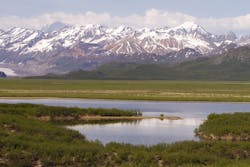Unattended Monitoring Devices Keep Water Flowing
The name Alaska is derived from the Aleut word Alyeska, meaning “great land,” and it certainly lives up to its moniker. Alaska is the largest but least densely populated state in the U.S., with a land area of 586,412 sq miles.
As employees of Anchorage Well and Pump Service (AWPS) know, that is a lot of territory to cover. AWPS, which has been in business for more than 35 years, is a water well service that manages more than 60 public water systems throughout the state.
Small Staff Has a Lot of Ground to Cover
When it comes to monitoring its public water system control rooms, AWPS has been relying on Sensaphone devices for more than 10 years. These systems allow the small AWPS staff to keep an eye on all the pump stations without having to regularly visit each one in person to ensure uninterrupted operation.
The communities AWPS attends to are outside Anchorage city limits, are served by their own wells and are home to 300 to 3,000 people. Even if they do not know it, these residents rely on AWPS to keep their water drinkable and flowing nonstop.
“Water treatment can’t be autonomous. It must be monitored continuously,” said Henry Martin, AWPS sales and service representative and 20-year community water expert. “We need to give our technicians all the support we can, and these devices are easy for our operators to program and use. They are extremely reliable, and we would not consider any other solution for our public water applications.”
The devices are used to monitor reservoir levels, system pressure, well house temperature, water pressure, water temperature and booster pumps, as well as to detect water on the floor and power failure. They also monitor chemical levels, because the water tends to be high in mineral content and must be treated for drinkability.
The immediate notification when equipment or environmental problems arise at the water stations is one of the most beneficial features of the monitoring systems. These instant alerts—sent by phone, fax or email—allow for quick, high-level decision making to avert water stoppage.
“Most people don’t think about their water until it’s gone,” Martin said. “Then it’s an emergency. These units have never failed in notifying us when something needs attention.”
Even when there is not an emergency, the monitors are hard at work collecting data. AWPS receives weekly reports from all monitored stations via fax every Monday morning.
“The weekly reports add an extra layer of assurance because they provide documentation of key tracking data at the various stations,” Martin said. “Reviewing the data log can help pinpoint time and conditions of any potential abnormalities or failures. It is a comfort that these monitors are watching our public water stations.”
Outdoor Monitoring in Remote Alaska
In addition to using Sensaphone monitors in its own pump and well operations, AWPS is a distributor of the products. One of its customers is the Alaska Department of Fish and Game, which oversees fisheries and game management units.
Rob Massengill, a fishery biologist with the department, was looking for a monitoring system that would notify his group if an outdoor generator failed. The generator was powering a chemical feeder that dispensed potassium permanganate (KMnO4), an oxidizing agent, into a small stream four miles northwest of Soldotna, Alaska, to neutralize a fish pesticide that had been used upstream. The monitor had to operate in extreme outdoor weather conditions—and without telephone or network access.
The solution was the Sat4D, a monitor that uses the Globalstar constellation of 40 low-earth orbiting satellites to work in even the most remote locations without relying on electricity, telephone lines, Ethernet connections or cellular networks.
“Our Sat4D worked flawlessly as part of a power loss alarm,” Massengill said. “The alarm system would notify us if the outdoor generator failed. Keeping the generator running was extremely important to prevent impacting downstream fish.”
[Visit Sensaphone's WWD Storefront]
“The benefit of using this family of monitors is not only the low investment cost, but also the durability, which is very impressive,” Martin said. “They have to be tough to survive Alaska. And if it’s important for you to buy American, they are all made in the U.S.”

